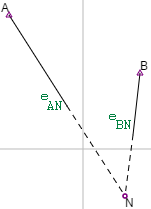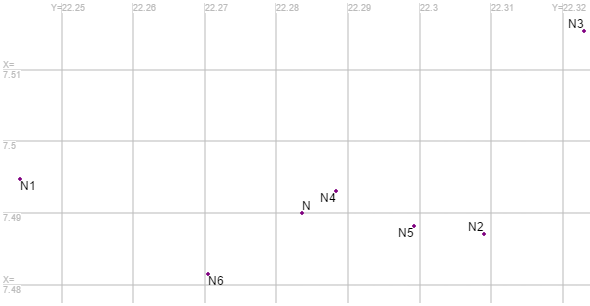
In geodesy we not only compute unknown quantities,
but we also estimate, how accurate or inaccurate such quantities are obtained.
Computed quantities inherit their deviations, the so-called errors
,
from the quantities, from which they are computed.
These quantities may have been measured and are affected by measurement errors
or computed from other quantities and so have again inherited their deviations.
It is said that errors propagate.
Both amplification as well as dilution of errors is possible.
It is important to carry out error propagations
These three goals are attained by the application of propagation laws.
Accuracies may be expressed by numbers in different ways. IN DUBIO PRO GEO works with the following three accuracy measures:
| standard deviation | Std | formerly known as mean error |
|---|---|---|
| maximum absolute deviation | Max | worst case error |
| weight | Wgt | a relative accuracy measure |
In geodesy the standard deviation is more popular because the maximum absolute deviation is difficult to estimate or yields values, which are theoretically possible, but only by a chain of worst cases.
A simple test for deviations to be sufficiently small is to repeat the computation with all accuracy measures halved and to check that also all computed measures are approximately halved.
For each accuracy measure there is a corresponding propagation law. Please find the theoretical basics explained here: (Sorry, only in German)
If for any uncertain start quantity a related measure of uncertainty is available then for some computation tools ( ) these measures may be specified and the related accuracy measures for all computed quantities are obtained. This requires the start quantities to be statistically uncorrelated. Practically this means that these deviations ultimately result from measurement errors, but each of them has affected only one start quantity.

How accurate can we determine the radius of a circular arc from tape measurements of the chord segments AQ and QE and chord offset PQ? From experiences we obtain for all three measurement values a standard deviation of 0.03 The result is a radius of 12.57 with a standard deviation of 0.18.
If we assume instead or additionally a maximum absolute deviation of the tape measurements of 0.1 each, then we obtain for the radius a maximum absolute deviation of 0.86.
In both cases the deviations are significantly amplified. This effect is even stronger for shallow arcs, which occur practically e.g. in traffic infrastructure construction.
If we would not know for sure, which standard deviation should be assigned to the tape mesurements, but only that they have a certain ratio, then we could work with weights. If these standard deviation are all equal, we choose the weight 1 for all measurements and compute the weight propagation. As a result we obtain for the radius the relatively small weight 0.028 which indicates a bad error propagation.
If we would try to determine the radius from measurements of the long chord AE and the two short chords AP and PE (⇑ figure) with the same accuracy, i.e., with the same weight 1, the we would obtain by weight propagation for the radius the even smaller weight 0.0034 This measurement setup is therefore even less recommendable.
Interesting enough, all these computations can as well be performed with . The triangle AEP is computed. The arc's radius equals the radius of circumcircle of this triangle. As an example we present the first computation in this version:
Although the does not support the error propagation directly, it is possible to skillfully compute an error propagation also here. Let us assume, we have n inaccurate start quantities (coordinates and/or measurements). You run the computation n+1 times, one time with unchanged start values and n times with one start value changed by its standard deviation or maximum absolute deviation, one after the other. The differences Δi of the desired results with respect to the first run of the computation are totalize according to the law of error propagation:
| for standard deviations | σ²= Δ1² +…+ Δn² |
| for maximum absolute deviations: | Δ=|Δ1|+…+|Δn| |
If you rename the points wíth changed coordinates and append them to the coordinate list and if you also assign different names to the n+1 results of the unknown points, then you can run the n+1 computations in the in a single flow .
The same works just as well with the computation tool .

Let us consider an arcs intersection with two known points A and B and an unknown point N as well as two measured horizontal distances eAN = 11.436; eBN = 6.576. The four position coordinates have standard deviations of 0.03 and both distances have standard deviations of 0.01. Consequently, we have 6 inaccurate start quantities XA,YA, XB,YB,eAN,eBN. Thus, the list of known points may read:
Y X
A 16.10 17.11 // unchanged point
B 23.06 14.02 // unchanged point
AY 16.13 17.11 // Y-changed point A
BY 23.09 14.02 // Y-changed point B
AX 16.10 17.14 // X-changed point A
BX 23.06 14.05 // X-changed point B
Now we compute the 7 arcs intersections in a single workflow by the and to the 7 results for the unknown point we assign the pointnames N,N1,N2,…,N6 . Every arcs intersection has two solutions. They combine to a total of 27=128 solutions. But it is sufficient to consider only the first one. All other solutions yield the same accuracies.
It is easy to display the spatial distribution of the 7 computed points by storing them in a coordinate list and looking at the canvas. The largest impact is made by the X coordinates of the known points A (→N1), B (→N3):

Now we must compute the differences Δi . This can be supported by and computation of a translation, such that N is moved to the origin of the coordinate system. The transformed coordinates of the other 6 points are immediately the desired differences. Finally, we obtain for the unknown point N by application of the law of error propagation for standard deviations:
σY=(0.039²+0.025²+0.039²+0.005²+0.016²+0.013²)½=0.065
σX=(0.005²+0.003²+0.025²+0.003²+0.002²+0.008²)½=0.028
If the given deviations would have been maximum absolute deviations then by application of the law of related error propagation we would obtain:
ΔY=0.138; ΔX=0.047
In both cases the deviations amplify mainly in the Y coordinate.
|
|
|
|